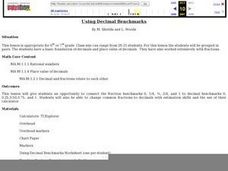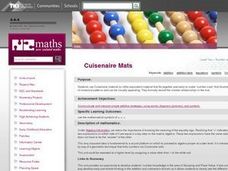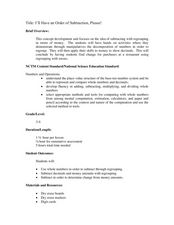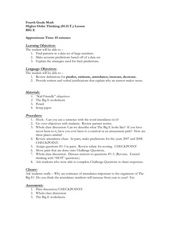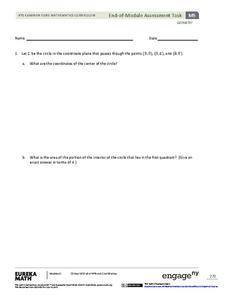Curated OER
Using Decimal Benchmarks
Students demonstrate some common operations done while using fractions based upon mathematical standards. They are also changing common fractions to decimals with estimation skills and the use of a calculator.
Curated OER
Cuisenaire Mats
First graders use Cuisenaire rods to study the mathematical symbols =, <, > for the relationships is equal to, is less than, and is greater than. They use the rods to show visual explanations of common number combinations.
Curated OER
Regrouping With Remediation
Fourth graders complete multiplication, addition, and subtraction problems that all contain regrouping. In this regrouping lesson plan, 4th graders complete worksheets not provided.
Curated OER
Seeing Numbers In Tens And Ones
Second graders develop the skill of place values up to the tens place. They practice identifying the values of 2 digit numbers and writing the correlating values with counting. They use the example of money to make the lesson more...
Curated OER
I'll Have an Order of Subtraction Please!
Students explore number values by completing consumer math worksheets. In this math functions lesson, students identify the use of a decimal in numbers and the place values that are represented when dealing with money. Students complete...
Curated OER
Exploring Teen Numbers
Students explore place value. In this numeration lesson, students use ten frames to represent numbers greater than ten. Students read two digit numerals and build the corresponding number using counters and ten frames. Students...
Curated OER
Global Statistics
Students select appropriate data to determine the mean, median, mode and range of a set of data. They calculate the statistical data on literacy rates and life expectancy within each geographic region of the world. Students determine...
Curated OER
Multiplication With Two Digits
Third graders multiply one and two digit problems, identify place value, and maneuver manipulatives to solve problems.
Curated OER
Comparing and Ordering Fractions
Students compare and organize different fractions. In this fraction instructional activity, students use wax paper divided into squares to represent fractions. Students put them in different orders based on their value to complete...
Curated OER
Double-Digit Addition with Regrouping
First graders recall place value system and double-digit addition, create and manipulate double-digit regrouping, and devise and identify ways to use regrouping.
Curated OER
Numbers Three Ways
In this problem solving skills instructional activity, students solve 8 problems that require them to make both sides equal using place value terminology.
Curated OER
Higher Order Thinking (H.O.T.) Lesson - BIG E
Fourth graders work with patterns while using large numbers. In this patterning lesson, 4th graders go over the definitions of the words: predict, estimate, attendance, increase, and decrease. They complete worksheets in which they track...
EngageNY
Geometry Module 5: End-of-Module Assessment
The lessons are complete. Learners take an end-of-module assessment in the last installment of a 23-part module. Questions contain multiple parts, each assessing different aspects of the module.
Rainforest Alliance
Investments in Forest Carbon
One hundred metric tons of CO2 can accumulate in one acre of forest over time—that's a lot of carbon! In the activity, groups of middle school learners determine what makes forests important. They then solidify the concept by using a...
BioEd Online
Good Stress for Your Body
Stress the importance of the different types of pressure our mind and body experience in a lesson about how certain types of stress are actually necessary and good for our bodies. As astronauts and people with injuries can attest, not...
Kentucky Department of Education
Multi-Digit Multiplication Strategies
There is more than one way to solve a multiplication problem, and many learners find that the lattice multiplication method can be a helpful one. Fourth graders take an initial formative assessment before working in groups of two or...
Alabama Learning Exchange
Converting Numbers from Base 10 to Binary, Octal, and Hexadecimal
How many different ways can you write the same number? Learners experiment with writing numbers using different bases. They progress from base 10 to base two, eight, and six.
Curated OER
What Can Data Tell Us?
Students analyze data they have collected themselves and by their classmates. In groups, they create data distributions to identify the highest, lowest and middle values. As a class, they discuss the concept of sample size and how it can...
Education World
High, Low, or In Between?
Trios play a card game that reinforces the concepts of number sequence and greater than and less than. Scholars make predictions based on information they know and a single unknown. They see cards drawn by others in the group, but not...
Curated OER
Number Sentences
Fifth graders become familiar with problem solving strategies of guess and check and working backwards. They demonstrate the basic concepts of addition, subtraction, multiplication, and division using a math sentence.
Curated OER
Acceleration of Gravity with Pendulums
High schoolers explore, analyze and study to see whether the length of a pendulum affects its period and whether the mass of a pendulum affects its period. They review and discuss a lengthy list of math definitions and experiment with...
Curated OER
The Number Match Game
Kindergarteners practice matching words and symbols by playing an index card activity. They create flash cards numbered 0 to 20 and challenge each other in groups to identify the values of the numbers. Learners utilize beans or buttons...
Curated OER
Comparing and Ordering Decimals - Complete Lesson Plan
Base ten blocks serve as visual representations of numbers that include decimals to the hundredths place. Children compare and order decimals in their math journal as they build the corresponding numbers with base ten blocks.
Curated OER
Everyday Mathematics: Ballpark Estimates
In this estimating practice worksheet, students sharpen their math skills as they learn how to make likely estimates and try the 2 extra practice activities.


